Space suits

Tomorrow marks exactly 49 years since the first space flight made by Yuri Gagarin in 1961. On this day, the entire planet celebrates World Aviation and Cosmonautics Day.
On this occasion, I decided to write a post about space suits - to tell about the history of their origin, the design and, if possible, to compare our space suits with their American counterparts.
')
A bit of pre-cosmic history
The need to create a spacesuit appeared in the early 30s. The fact is that test pilots even in oxygen helmets could not rise to heights greater than 12 km due to the reduced atmospheric pressure. At this height, the nitrogen dissolved in human tissues begins to pass into a gaseous state, which leads to the appearance of pain.
Therefore, in 1931, engineer E. Chertovsky designed the first H-1 spacesuit. He was a simple sealed jumpsuit with a helmet, equipped with a small glass for the review. In general, in the "CH-1" could do anything, but not to work. Nevertheless, he became a breakthrough. Later, before the war, Chertovsky managed to design six more models of spacesuits.
After the war, the first fighter jets began to appear, which sharply lifted the bar of maximum heights. In 1947-1950, a group of designers under the leadership of A. Boyko created the first post-war air scaffolds, called VSS-01 and VSS-04 (high-altitude rescue spacesuit). They were hermetic overalls made of rubberized fabric, to which fixed folding helmets and oxygen masks were attached. The excess pressure at the height was relieved with a special valve.
Start of development
In general, the development of spacesuits at first was not very good with us. The fact is that the existing developments of spacesuits were useless in the event of a ship depressurization in space. And the designers have nothing to do with it - they were simply given the task to develop a protective suit designed to save the astronaut only after landing or splashing down the descent module. Among the spacesuit opponents were even some of the designers of the ship — they considered the possibility of depressurization negligible. Their words were confirmed by the successful flight of the Laika in the MLC (hermetic animal cabin).

Disputes could be stopped only after the personal intervention of the Queen. In this case, before the flight of Gagarin had only 8 months. During this time, the spacesuit SC-1 was created.
SK-1
In total there are 3 classes of space suits:
• rescue spacesuits - serve to protect astronauts in the event of a cabin depressurization or in case of significant deviations of its gaseous environment parameters from the norm;
• spacesuits for work in open space on or near the surface of a spacecraft
• spacesuits to work on the surface of celestial bodies
SK-1 was a spacesuit of the first category. It was used during all flights of the ships of the first series "Vostok"

CK-1 “worked” in a pair with a special heat-proof overalls, which was put on by an astronaut under a basic protective suit. The jumpsuit was not just clothing, it was a whole engineering structure with ventilation systems installed in it, which supported the necessary thermal conditions of the body and removed moisture from the breathing products. In unforeseen conditions, the life support system of the spacesuit (LSS) together with the LSS cabin “extended” the existence of an astronaut for 10 days. In the case of cabin depressurization, a transparent “visor” was closed — the helmet's porthole — and the air supply from the ship's cylinders was turned on.
But he had a significant drawback. Its soft shell under the action of internal overpressure always seeks to take the form of a body of rotation and straighten. To bend any part of it, say, a sleeve or a leg, is not so easy, and the greater the internal pressure, the harder it is to do. When working in the first space suits, because of their relatively low mobility, astronauts had to expend considerable additional efforts, which ultimately led to an increase in the intensity of metabolic processes in the body. Because of this, in turn, it was necessary to increase the mass and dimensions of oxygen reserves, as well as the cooling system units.
The spacesuit SK-2 was also created. In fact, this is the same SC-1, only for women. He had a slightly different form, taking into account their physiological features.
Analog
The American equivalent of our SK-1 was a spacesuit for the ships "Mercury". It was also an exclusively life-saving suit and was made in 1961.

In addition, he had a metallized outer layer to reflect the heat rays.
Golden eagle
In the middle of 1964, the leaders of the Soviet space program decided on a new experiment in orbit - the first man to leave the spacecraft in the open space. This circumstance posed a number of new technical tasks to the developers of spacesuits. They, of course, were dictated by the serious differences between the internal environment of a spacecraft and the conditions of external space - the realm of almost complete vacuum, harmful radiations and extreme temperatures.
The developers had two main tasks:
Firstly, the spacesuit had to protect against overheating, if the astronaut is on the sunny side, and, conversely, from cooling - if in the shade (the temperature difference between them is more than 100 ° C). He also had to protect from solar radiation and from meteoric matter.
Secondly, to ensure maximum safety to the person, to be extremely reliable and to have the minimum volume and weight. But the most important thing is that with all this the astronaut in him must be efficient, i.e. move around a ship, do some work, etc.
All these requirements were implemented in the “Berkut” spacesuit.
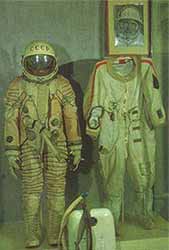
By the way, starting with the "Berkut" all our space suits began to be called bird names.
The suit was made of several layers of film with a shiny aluminum surface. The space between the layers specifically had a gap in order to reduce heat transfer in any direction. The principle of a thermos - heat is not taken and not given away. In addition, the layers of film-tissue are separated by a special mesh material. As a result, a very high level of thermal resistance was achieved. The cosmonaut's eyes were protected by a special light filter made from tinted organic glass with a thickness of almost half a centimeter. He played a dual role - weakened the intensity of sunlight and did not let the biologically dangerous part of the rays of the solar spectrum to face.
The first spacewalk had limited tasks. Therefore, the life support system seemed relatively simple and was designed for 45 minutes of work. It was placed in a knapsack with an oxygen device and cylinders with a capacity of 2 liters. On the case of the knapsack fastened fitting for their refueling and the window of the gauge to control pressure. Air was taken from the ship, which was additionally enriched with oxygen and entered the spacesuit. The same air carried away the warmth, moisture, carbon dioxide and harmful impurities allocated by the astronaut. Such a system is called an open type system.
The whole system fit in a knapsack of 520x320x120 mm in size, which was fastened to the back using a quick-release connector. In an emergency, a reserve oxygen system was installed in the airlock chamber, which was connected to the spacesuit with a hose.
Analog
An analogue for the golden eagle was the spacesuit for the ships “Gemini”

His ship version (I don’t know how to call it otherwise) was a normal rescue spacesuit. The modified version was designed to work outside the spacecraft.
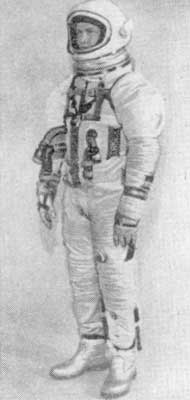
For this purpose, shells of thermal and micrometeoritic protection were added to the basic spacesuit.
Hawk
From 1967, flights of the new Soyuz-type ships began, the fundamental difference between which and the predecessors was that they were already manned aircraft. And, therefore, the potential time of man and space outside the ship was supposed to increase. Accordingly, it was impossible to be in the spacesuit all the time. He put on only in the most crucial moments - takeoff, landing. In addition, the question arose of putting several ships into orbit, their docking, which implied operations involving the passage of people through outer space.
For these purposes, a new spacesuit with a new life support system was developed. He was called "Hawk"

This spacesuit was basically similar to the "Berkut", the differences consisted in a different system of respiratory installation, which belonged to the so-called regeneration type. The respiratory mixture circulated inside the suit in a closed loop, where it was purified from carbon dioxide, harmful impurities, fed with oxygen and cooled. Oxygen cylinders remained part of the system, however, the oxygen contained in them was used only to compensate for leaks and to consume the cosmonaut. For this system, several unique units had to be created at once: an evaporative heat exchanger operating under specific conditions of weightlessness; carbon dioxide absorber; an electric motor that functions safely in a pure oxygen atmosphere and creates the necessary circulation of air inside the spacesuit, and others.
Air cooling was used to cool the cosmonaut's body. To do this, it is necessary to drive a very large amount of gas through the spacesuit. This, in turn, requires a fan with a capacity of several hundred watts, as well as high energy costs. And strong airflow is not very pleasant for an astronaut.
A noticeable plus was the fact that the spacesuit's mass does not exceed 8-10 kg, and the thickness of the envelope package is minimal. This makes it possible to use it with an individual invoice of shock-absorbing seats, which weaken the effect of overloads during orbit and descent.
In practice, the "Hawk" was used only once - to go from the "Soyuz-5" to the "Soyuz-4".
Analog
I did not find a specific American counterpart to the “Hawk”. Partly under it like a spacesuit fits for the early "Apollo"

Krechet
An innovative spacesuit of the 3rd category was built for the flight to the moon. In a spacesuit, the astronaut had to retain such motor and working abilities as are considered elementary on the earth. For example, to move on the lunar surface, taking into account the fact that "walks" can occur in different reliefs; to be able to stand up in the event of a fall, make contact with the lunar “ground”, the temperature of which varies in a very wide range (in the shade and in the light from -130 ° C to + 160 ° C); work with instruments, collect samples of lunar rocks and produce primitive drilling. The astronaut should have been provided with the opportunity to fortify himself with special liquid food, as well as to remove urine from the spacesuit. In short, the entire life support system was calculated on more difficult working conditions than those that existed during the orbital exits of the researchers.
Considering these requirements, under the direction of A. Stoklitsky, the Krechet spacesuit was created

It had a so-called "semi-rigid" shell, and instead of a backpack, it had an integrated life support system. It was from him that the phrase "enter the spacesuit" went. Because the cosmonaut entered the “Krechet” using the “door” on the back. In the "door" was placed all the life support systems.
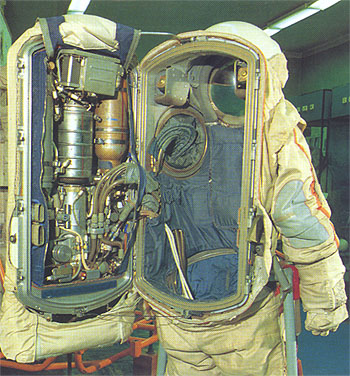
“Krechet” systems provided a record autonomous stay of a person on the Moon - up to 10 hours, during which the researcher could perform work with great physical exertion. For the first time, a water cooling suit was used for thermal cooling, since water cooling is the only possible method of maintaining acceptable thermal conditions in a spacesuit with intensive work of an astronaut. To remove 300–500 kcal / h of heat, the water flow through the water cooling suit was 1.5–2 l / min, the required length of the cooling tubes was about 100 meters. For pumping water pump was used with an engine capacity of several watts.
Simultaneously with the water cooling there was a circuit for the circulation and regeneration of the air environment inside the spacesuit and the removal of moisture. There was also a supply of oxygen to compensate for leaks.
Analog
This is perhaps the only case when the American equivalent is more famous than ours. It was in him Neil Armstrong set foot in 1969 on the surface of the moon

The suit was made of high-strength synthetic fabrics, metal and plastics. Under the spacesuit, the astronaut wore a light one-piece suit with sensors for biotelemetry. In addition, a special suit of water cooling was put on under the suit, which was designed for continuous operation for 115 hours. In this suit of nylon spandex there was a system of PVC tubes with a total length of about 90 m, through which cold water was continuously circulating, absorbing the heat generated by the body and diverting it to an external refrigerator. Thanks to this suit, the temperature of the skin in various parts of the body did not exceed 40 ° C.
There were special wire ties on the palm, which did not allow the glove to swell under pressure in a spacesuit. To ensure the dexterity of working with hands on the fingers of the gloves, there were lengthening-grips with which the astronaut could lift small objects.
The astronaut's helmet is made of transparent polycarbonate and has great impact strength. Its spherical shape gave the astronaut the opportunity to turn his head in any direction. Oxygen entered the helmet at a speed of 162 l / min, and the pressure connector on the left side of the helmet allowed the astronaut in a spacesuit to drink or eat food. The life-support knapsack system was attached to the back of the spacesuit and the oars on Earth were 56.625 kg (for especially meticulous ones - 554.925 n).
Orlan
After landing on the moon, all the work on the "Krechet" stopped. However, the Orlan suit was also included in the lunar program kit for orbital operations.

Returned to its development in 1969, when work began on the first orbital station. It is the modifications of the Orlans that we used on the Mira and are now being used on the ISS.
Everyone knows that the crews at orbital stations are changing.
However, the pre-existing space suits were individual and did not have the ability to fit. Consequently, for each new member of the station crew, they needed to be manufactured and launched into space, which was inefficient with limited cargo capabilities of the Soyuz and Progress ships. However, thanks to the semi-rigid construction at Orlan, only the spacesuit gloves were delivered by the crew, while the spacesuits themselves were constantly at the station.
To ensure body mobility, hinges were used in the spacesuit located in the area of the main joints - shoulder, elbow, knee, ankles, fingers, etc. In addition, in subsequent modifications, hermetic bearings were used to increase mobility , in the humeral or wrist joints).
Since the first use of the Orlan in the Salyut-6 in 1977, until the Mira flooded in 2001, 25 sets of Orlans of all varieties were used in near-earth orbit. Some of them burned down together with the last station "Mir". During this time, 200 exits by 42 crews were made at the Orlans. The total work time exceeded 800 hours.
Orlan has many modifications. The most interesting in my opinion - "Orlan-DMA" with the installation for moving and maneuvering in outer space.
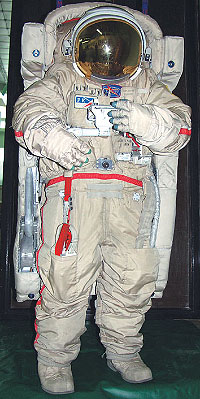
SPE "Star" does not sound the cost of "Orlan". However, in one report I once heard a figure of a million dollars. I can be wrong.
Analog
American astronauts honestly and openly admit that their current spacesuits are much worse and more inconvenient than ours. They cost while 12-15 million. So a full-fledged analogue of the current Orlans does not exist.
Swift
During the creation of the "Buran" created the newest life-saving suit "Swift"
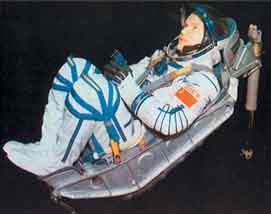
I’m not completely sure that it’s him in the photo, but it’s like him. Included with the "Strizhu" was developed ejection seat K-36RB. Experts called "Swift" the best spacesuit ever. However, with the cessation of work on the "Buran" ... in general, as usual in our country.
PS I apologize for the quality of photos, especially American space suits.
If you like the article, I’ll try to write a post about Shuttles and Burans for a couple of days. Only habrodaktsiya, do not forbid, please, space posts. I didn’t write the sequel about Flounder .
Source: https://habr.com/ru/post/90662/
All Articles